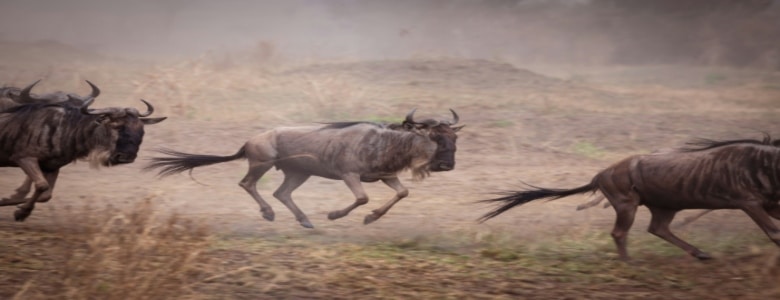
The grasslands of the African savannah teeming with vast herds of migrating wildebeest are a wonder of the natural world. Their journey following the monsoon rains has been repeated for millennia; it is also a journey of regeneration and survival. The instinct and innate drive forward to fresh pastures bring the wildebeest into contact with lions, leopards, and other predators as the circle of life continues its irrepressible momentum.
The scene of the hunter and the hunted in a battle for survival is repeated throughout the animal kingdom. It also provides an analogy for investing.
The Initial Panic
Wildebeest are highly sensitive to threats, constantly looking out for predators and responding swiftly to the slightest hint of danger. A pride of lions in hunting mode will cause the flight response to kick in as the first members of the herd spot the risk and react.
Similarly, in the stock market, investors react to news and events that might threaten their financial well-being. These threats can range from socio-economic events such as a sudden rise in inflation, geopolitical tensions, a banking crisis or a global pandemic. Whatever the trigger, as with the appearance of a hungry lion, the first thought of the nervous investor is to protect themselves and sell their investments before they lose too much.
The Spread of Fear
As the first few wildebeest start running, others join in, even if they haven’t seen the predator themselves. The fear is contagious, and the stampede starts. In the stock market, this contagion effect also creates herd behaviour. Investors see others selling and fear that they might miss the chance to sell before prices drop further. This amplifies the panic, causing more sales and a steeper decline in prices.
During these times, rational decision-making often takes a back seat. The fear of losing money overshadows objective analysis, much like how wildebeest prioritise immediate escape over assessing the actual threat level. The market, driven by emotion rather than fundamentals, experiences significant volatility.
The Calm After the Panic
Eventually, the wildebeest come to a halt. The threat either passes or is not as severe as first feared. The herd calms down and resumes grazing. Similarly, in the stock market, after the initial panic subsides, investors begin to reassess the situation. They analyse whether the threat was real or exaggerated; new data shows assumptions were false, misinterpreted or overblown.
If the initial trigger for the sell-off turns out to be a false alarm, is addressed effectively or share prices become so low early investors now see opportunities rather than threats, confidence returns and investors start buying again, stabilizing the market. Over time, prices recover as rationality returns and the number of buyers exceeds the number of sellers re-establishing the long-term upward trend in markets.
Lessons from the Stampede
Just as a rustle in the grass can start a stampede, stock market crashes are often triggered by events that create uncertainty. Sticking to the plan and remaining invested is crucial; we invest with a long-term goal in mind; if the goal hasn’t changed, neither should the plan. Investing isn’t a life-or-death situation; on the African plains the old and weak get eaten, and the fit and strong survive. In the world of investing, the losers are the ones who react emotionally. The winners are those who act with patience and discipline when nobody else is.
Photo by Helena Pfisterer on Unsplash






